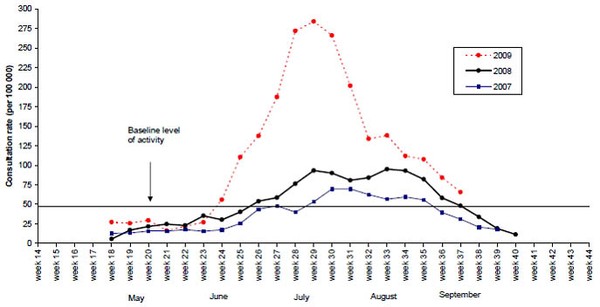Pandemic Influenza (H1N1) 09 Swine Flu - Update 152

While numbers of swine flu cases in New Zealand appears to be declining the virus is still circulating. It is still important that good hygiene habits are kept up to dampen down spread of the virius from one person to another - that means covering coughs and sneezes and regular, thorough washing and drying of hands. It is also important people stay at home if they become unwell - in other words don't take viruses out of the house - and seek medical help if they have underlying health conditions or symptoms worsen.
Latest Numbers
There are a total of 3161 confirmed cases of Pandemic Influenza (H1N1) 09 swine flu, compared with 3152 on 16 September. These are people who have returned a positive laboratory test for pandemic influenza (H1N1) 09. The actual number of cases of Pandemic Influenza (H1N1) 09 will be significantly higher, as only a small proportion of people with symptoms have been tested.
The number of deaths from Pandemic Influenza (H1N1) swine flu where swine flu was a primary cause is 17. Other deaths are being investigated by the Coroner.
Numbers of people in hospitals with the Pandemic Influenza (H1N1) 09
As at midday today, three people were reported to be in hospital with Pandemic Influenza (H1N1) 09 or its complications.
Healthline Calls
The percentage of callers to Healthline with influenza-like symptoms continues to decline and are now at the rate of this time last year.
GP Consultations
The data above are from the Institute of Environmental Science and Research's (ESR) sentinel general practice surveillance system. They show that at its peak, the weekly consultation rates for influenza-like illness (ILI) were nearly three times higher than the winter peak in the last two years. The number of ILI consultations continues to decrease, although is still a little higher than at the same time in previous years.
Australian Situation
For the number of confirmed cases in Australia, go to the Australian Government's Department of Health and Ageing website at:
http://www.healthemergency.gov.au/internet/healthemergency/publishing.nsf/Content/updates
International Update from the World Health Organization
Pandemic (H1N1) influenza virus continues to be the predominant circulating influenza virus, both in the northern and southern hemisphere.
In the temperate regions of the southern hemisphere, influenza activity continues to decrease or has returned to the seasonal baseline in most countries.
In the temperate regions of the northern hemisphere, influenza activity remains widely variable. In North America, the United States is reporting increases in influenza-like-illness activity above the seasonal baseline, most notably in the southern, southeastern, and parts of the northeastern United States, while inn Canada influenza activity remains low.
In Europe and Central Asia influenza activity remains low overall, except in France, which is reporting increases in influenza-like-illness activity above the seasonal epidemic threshold. Geographically localized influenza activity is being reported in several countries (Austria, Georgia, Ireland, Luxembourg, Norway, Portugal, the Czech Republic, Cyprus, and Israel). In Japan, influenza activity remains stably increased above the seasonal epidemic threshold.
In the tropical regions of the Americas and Asia, influenza transmission remains active. Geographically regional to widespread influenza activity continues to be reported throughout much of South and Southeast Asia, with increasing trends in respiratory diseases being reported in India and Bangladesh.
Geographically regional to widespread influenza activity continues to be reported for the tropical regions of Central and South America, without a consistent pattern in the trend of respiratory diseases (continued increases are being reported in Bolivia and Venezuela).
